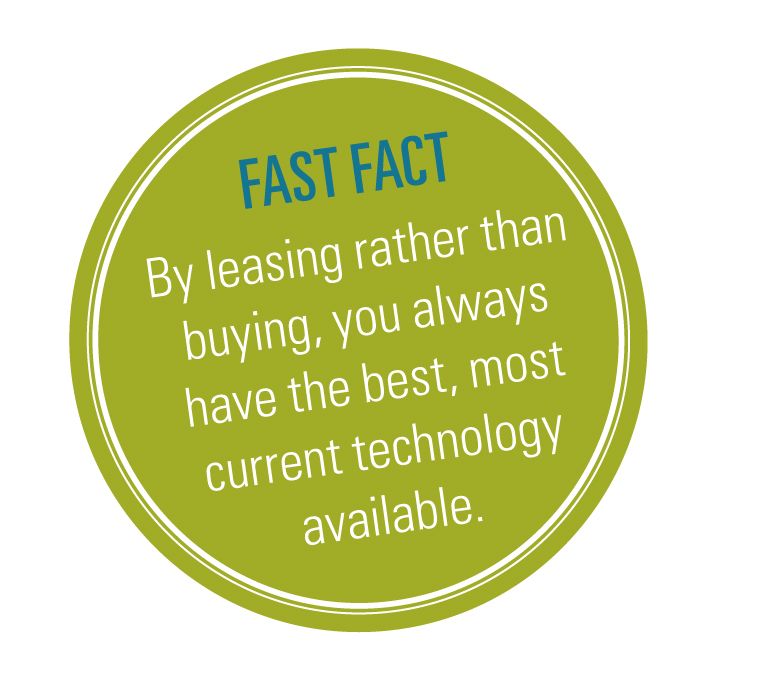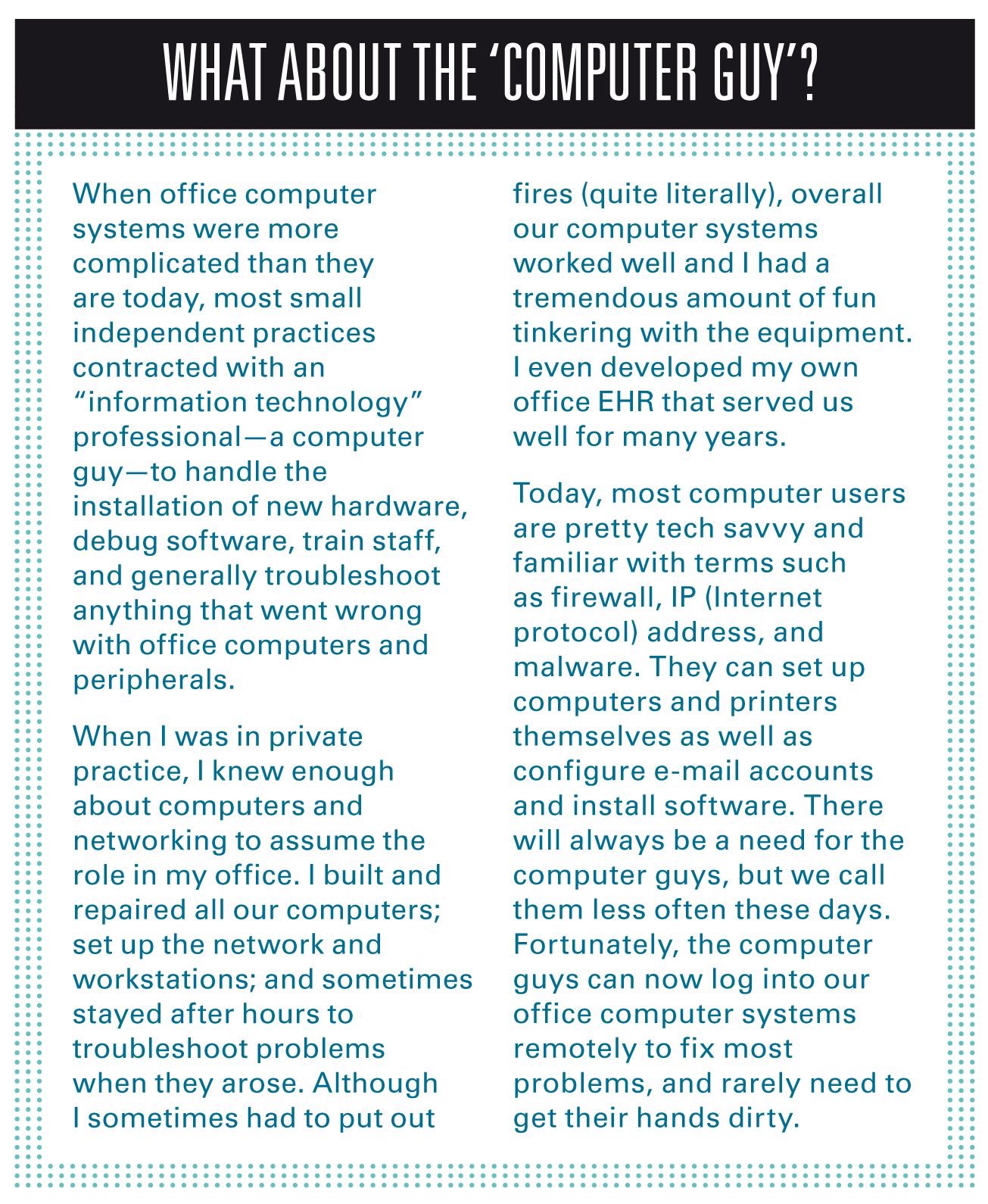Office electronics: Choosing the best tech
Previous Peds v2.0 articles have discussed cutting-edge technologies for screening patients and for expediting diagnoses. The technologies that are just as important in the pediatric office practice are the many electronic devices we often take for granted. Here’s the scoop on the tech you need to run an efficient, modern pediatrics practice.
Previous Peds v2.0 articles have discussed cutting-edge technologies for screening patients for vision problems, lipid disorders, anemia, and lead poisoning; and for expediting the diagnoses of patients with strep, influenza, and respiratory syncytial virus infections. I have also discussed mobile devices that help to monitor patients with conditions such as obesity, asthma, and diabetes. The technologies that are just as important in the pediatric office practice are the many electronic devices we often take for granted, including printers, computers, tablets, keyboards, and mice. Here is my advice on choosing the best office technologies to help your practice run efficiently.
Once upon a time . . .
There was a time not too long ago when practices ran completely without computers. We used scheduling books, paper charts, superbills, and appointment cards. Practices ran smoothly and efficiently despite being “low tech.” In those simpler times, patients would pay their bills at the checkout window and be given a superbill form, which allowed them to be reimbursed directly by their insurance companies for services rendered.
Back in those days, practices were quiet and calm because there were no clicky-clacks on keyboards; no hum of printers preparing to spit out documents; no all-too-familiar warbles of credit card machines dialing and seeking an electronic connection. Today, contemporary medical practices depend on computer systems to function efficiently, and we would be lost without them. Pediatricians now use practice management computer systems for scheduling and electronic billing, and many practices have either adopted or are considering adopting an electronic health record (EHR).
Over the past 10 years, computers have become more powerful; hard drives have gotten faster and larger; and computer monitors have gotten slimmer and lighter. Fortunately, most computers and computer peripherals have also become very affordable. I recall that my first office computer in 1986 cost $12,000! Back then, the first laser printer cost $3,600. Today, quality computers can be had for less than $1,000, and some laser printers sell for less than $100.

Making good choices
If I were to equip a small- to moderate-sized pediatric practice today, I would make different choices than I did years ago. High bandwidth Internet access is inexpensive and reliable, and many services are migrating from desktop applications to those accessible via the “cloud.”
As discussed last month (Contemp Pediatr. 2014:31(3):35-38), many pediatricians are dissatisfied with their EHRs, and many of us either have switched or are considering switching systems. Consequently, to avoid purchasing an expensive EHR, I would implement the Practice Fusion EHR (San Francisco, California). Practice Fusion is an advertising-supported, highly rated, free cloud-based EHR that satisfies all current “meaningful use” requirements and integrates nicely with online billing services.

I would set up workstations with printers in all exam rooms. To accomplish this, I would implement a secure wireless network using high-speed routers that support the newest (and fastest) 802.11ac standard, which recently became available. I have had excellent luck with Netgear (San Jose, California) products and would recommend either the R6300 ($170) or the R7000 ($200) high-speed router that supports the new wireless standard.
I would also choose a computer with a very small footprint. Asus (Taipei, Taiwan) markets a “small box” personal computer (PC), the VivoPC M40B, that measures 7.5 in x 7.5 in x 2 in and runs Windows 8. It comes equipped with 2 gigabytes (GB) of RAM and a Haswell Celeron dual-core processor. The M40B has a 500 GB hard drive and supports 802.11ac connectivity. This $300 computer is more than adequate for running an EHR and features Bluetooth connectivity, excellent speakers, and a wireless mouse and keyboard.
If you are looking for a slightly more powerful computer, you can upgrade to the $550 VivoPC M60, which is the same size as the M40B but is equipped with an i5 processor, 4 GB of RAM, and a 1 terabyte hard drive. Both systems include the hardware needed to attach the system to the back of any standard flat-screen monitor-out of sight and away from curious patient hands.
I don’t have a favorite flat-screen monitor, but a 23-in monitor is a practical size and one can usually be purchased for $200 or less. Monitors adequate for office use are sold by Samsung (San Jose, California), LG (Seoul, Korea), Acer (San Jose, California), Dell (Round Rock, Texas), and Hewlett-Packard (HP; Palo Alto, California).
Running Windows in an office environment requires good antivirus software. Norton AntiVirus by Symantec (Mountain View, California) has always been my personal favorite and consistently earns high ratings among software reviewers. You can run Practice Fusion on Apple (Cupertino, California) computers, but Apple computers tend to be much more expensive than comparably equipped Windows-based PCs, and only Apple’s newer laptops support the new 802.11ac wireless standard. These include the $999, 11-in MacBook Air or the $1,299, 13-in MacBook Pro with Retina display. Chromebooks that run the simple and fast Chrome operating system (OS), such as the $300 Acer c720p, are inexpensive and practical alternatives to Windows-based PCs for running the Practice Fusion EHR. Advantages include a small 11-in size and touch screens, as well as the capability to connect to a large-screen monitor. Chromebooks boot instantly and are very quiet. Because Chrome OS is a Linux-based system, no antivirus software is needed.
I don’t think it’s practical to carry a heavy laptop from room to room. However, if you insist on the portability of a laptop and don’t mind the expense, I would choose a compact ultrabook, such as the Lenovo (Morrisville, North Carolina) ThinkPad X1 Carbon ($1,300) that is very light at only 2.9 lb and powerful. Also, the MacBook Air is a great alternative. I have had excellent luck with Apple and Lenovo laptops over the years and consider them well constructed and extremely durable. You can easily attach a laptop to a large screen monitor. Doing so and using a wireless mouse and full-size keyboard will make it easier for staff to input data.

As for printers in the exam room, small and speedy are best, and those that connect via a wireless network will minimize the number of cords. I have had good luck with the $130 HP LaserJet Pro P1102W. This printer has a small footprint; features instant-on technology (no warm-up); and is fast (19 pages per minute). In addition, replacement toner cartridges are fairly inexpensive.
Having printers in exam rooms improves workflow because you and your staff do not need to retrieve printouts from the printer down the hall. For the main office, it is best to lease a high-speed, Internet-connected, multifunction printer/scanner/fax/copier system that can perform both duplex scanning and duplex printing to reduce your paper usage. By leasing rather than buying, you always have the best, most current technology available.
Accessories
In my view, the best medical office keyboards and mice are made by Seal Shield LLC (Jacksonville, Florida). These accessories are office friendly because they feature a silver-impregnated antimicrobial surface that inhibits the growth of potentially harmful microbes including viruses, bacteria, and fungi. Computer input devices and mobile devices are an underrecognized source of contagion not only in hospitals and medical offices but also in homes, schools, and day cares. One study demonstrated that staphylococci, gram-negative rods, enterococci, Bacillus species, and others could be cultured from more than 50% of keyboards in medical environments.1 Additionally, these devices are spill proof, fully sanitizable with a variety of disinfectant solutions, and fully submersible. They can even be cleaned in a dishwasher!
My current favorite is the new Seal Shield Silver Wave Ergonomic Keyboard that sells for $100. Its curved design prevents the typing fatigue that most providers and staff experience by the early afternoon, and “hot buttons” on the keyboard quickly access the computer calculator, e-mail program, and favorite search engine. Seal Shield's website features a wide variety of wireless and wired keyboards, mice, and input accessories, as well as silver-impregnated and washable television remote controls, pens, and mouse pads. You can cover your iPhone and iPad with Seal Shield Shield Covers-sleeves that make the devices fully waterproof and sanitizable. The company backs all products with a limited lifetime warranty. Check www.sealshield.com for a full list of products. You can also recommend these input devices to your patients' parents as a way to reduce the spread of infections at home.
Tablets, tablets, more tablets
I frequently use my iPad to access the many resources described in previous articles, and I encourage practices to use the Child Health and Development Interactive System (CHADIS; Total Child Health Inc; Baltimore, Maryland) software on a tablet in the waiting area. The CHADIS tool allows parents to complete development screening questionnaires prior to an office visit. When placed in suitable protective cases such as the OtterBox Defender (Otter Products LLC; Fort Collins, Colorado), tablets can easily survive the waiting-room experience.
Apple introduced the tablet computer just a few short years ago in 2010, and the iPad has truly changed the way we use computers. The tablet market is quite competitive now. I still favor Apple tablets over Android tablets, and I use the iPad Air myself for browsing the Web and accessing medical resources. The best Android tablet in my view is the Nexus 7 from Asus. This would be a reasonable substitute for waiting-room use because it costs roughly half what an iPad costs. However, it is not as durable.
For your personal use, be aware that Android tablets are slowly catching up to the iPad in terms of the number of medical applications available. The American Academy of Pediatrics apps are available on both tablet types, as are Epocrates and Medscape, which provide some of the best resources for pediatric providers. As of this writing, the popular Contemporary Pediatrics app has no Android version. Windows tablets, unfortunately, have very few applications for medical professionals at present.

And all the other stuff . . .
Keep in mind that it’s worth your time and effort to keep a clean, uncluttered work area. This means that you can use select accessories available from websites such as quirky.com, ThinkGeek.com, and Staples.com to buy cable organizers and ties that keep your computer and tablet cables neatly organized. I now use a charging station for all my tablets and smart devices, thereby reducing the number of cables needed to keep my electronic office appliances powered and ready for use at all times.
Despite all the electronic equipment, one of the most valuable nonelectronic accessories I always will keep handy is my stack of colored Post-It notes, which never fail to get the attention of my colleagues and staff!
REFERENCES
1. Rutala WA, White MS, Gergen MF, Weber DJ. Bacterial contamination of keyboards: efficacy and functional impact of disinfectants. Infect Control Hosp Epidemiol. 2006;27(4):372-377.
Dr Schuman is adjunct associate professor of pediatrics at the Geisel School of Medicine at Dartmouth, Lebanon, New Hampshire. He is section editor for Peds v2.0 and also an editorial advisory board member for Contemporary Pediatrics. He has nothing to disclose in regard to affiliations with or financial interests in any organizations that may have an interest in any part of this article.